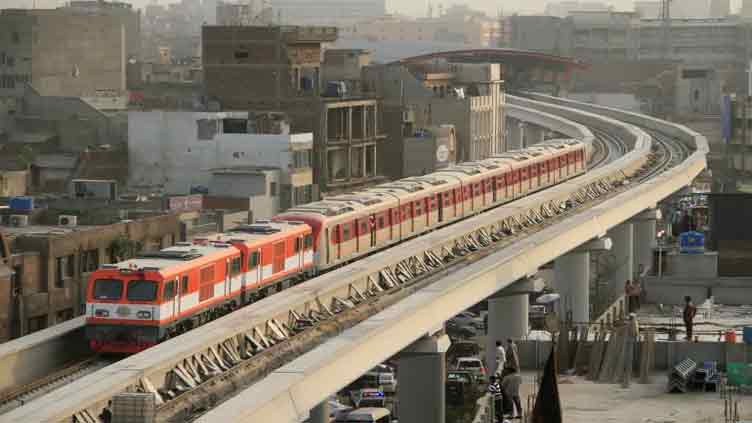Around three dozen people – both men and women – are constantly ignoring the repeated announcements and pleas made by multiple rickshaw and Chingchi drivers. They won’t pay any attention as they wait for feeder bus – the system run by the Punjab Masstransit Authority.
As soon as the bus – the smaller one with one exit only – arrives, they rush towards it, making it difficult for those intending to disembark and thus forcing them to yell “Wait a bit. First allow us to leave.” Moments later, all of them are able to leave the bus as new passengers pushed their peers to manage some space in the bus.
Meanwhile, one or two passengers standing right at the door are making it difficult for the driver to close the door, who is pleading on speaker to either move a step forward or board the next bus. However, no one listens to him. After repeated attempts, the driver is able to shut the door and the bus starts moving again.
It takes around well over a minute, although the time fixed for a stop is 15 seconds, but the high number of passengers exiting and entering the bus mean it is impossible for the driver to follow the rule.
These scenes are a daily routine in Lahore – especially during rush hours – which has a limited number of feeder bus routes apart from two mass transit lines – Metrobus and Orange Line.
Most of these buses has two exits – one each for men and women compartments – but the smaller single-door buses are also in use on some routes.
However, the short story narrated in the abovementioned example is applicable to almost all routes and busy points – bus stops – as well as the Metrobus and Orange Line.
It’s inflation. The PMA’s integrated transport system is much cheaper than other modes of transport – Rs15 for one ride in case you have a card with additional Rs5 charged if you board one or two more bus(s) within one hour of exiting the previous one. It means your entire journey cost Rs15 or Rs20 or Rs25 only. The time is calculated when you validate the card for the second time while leaving the bus.
In case of cash, every passenger has to each Rs20 for each ride.
The number of people availing the service is growing at a rapid rate just like the inflation as people not only want to have a respectable service but also save money amid the unprecedented financial crisis.
Integrated transport system is a must for any city as it enables people to reach shuttle between their homes and working place easily while saving both precious money and time. But with the rising prices of every daily-use item and service, more and more people have no choice but to opt for austerity and this system provides them the best opportunity.
The record-rise in petrol and diesel prices means a large chunk of your income is consumed by the transportation cost as the overwhelming majority can’t afford rickshaw and Chingchi or app-based services like Uber, Careem and inDrive.
Certainly, this system is a great refuge for the masses.
Lahore, the second-largest city in Pakistan, was supposed to have at least four mass transit lines and around 1,500 feeder buses with over 120 routes for the country’s first integrated transport system. But politics ruined everything.
First came the delay in the Orange Line construction. It was politically motivated. As a result, the then Shehbaz Sharif-led Punjab government could neither launch the remaining mass transit lines or add to the feeder bus fleet. They even didn’t bother to introduce the planned feeder bus routes for Orange Line. No need to recall the entire episode. You know everything unless political bias affects your thinking.
The PTI tenure saw an intentional effort to destroy the system – no new mass transit line added, no new feeder bus imported. Even the existing Metrobus line has been neglected since then due to very little maintenance.
Zero expansion means the system can’t cater to the needs of the megacity. It urgently needs new mass transit lines and feeder buses to ensure expansion. Even the existing routes need reduced head time – the gap between the two buses leaving the starting point. Currently, it ranges from seven to 20 minutes for different routes.
The then PML-N government during its 2013-18 tenure failed to launch the feeder bus service in one go as the PMA opted for a phase-wise introduction. In simple words, the introduction of feeder buses had been made conditional to the construction of new mass transit lines – a move that makes no sense – while erstwhile Lahore Transport Company (LTC) was also shut down.
Obviously, the closer of LTC was necessary after the introduction of this integrated transport system. However, the foreign-educated managers of PMA failed to understand that they must at least replace the LTC buses and routes with the new feeder bus system while keeping expansion in mind.
And this loophole was fully exploited by the PTI government.
Perhaps, one of the biggest jokes played with the people of Pakistan by the Musharraf regime was the introduction of Chingchi. Now these Chingchis are biggest source of noise pollution in urban centres.
This inflation phenomenon and the global warming have made the case for mass transit system in every city of Pakistan even more stronger. But we first have to disembark from Chingchi to even think about that.
Post Views: 64


 Sports3 months ago
Sports3 months ago
 Fashion2 months ago
Fashion2 months ago
 Sports3 months ago
Sports3 months ago
 pakistan3 months ago
pakistan3 months ago
 pakistan3 months ago
pakistan3 months ago
 World2 months ago
World2 months ago
 World3 months ago
World3 months ago
 Sports2 months ago
Sports2 months ago



















